Scottish Employer Perspectives Survey 2021
Results from the 2021 Scottish Employer Perspectives Survey.
People Development
This chapter focuses on people development. The topics covered include approaches to training; views on vocational qualifications; awareness of schemes or initiatives that help people development; and collaboration with other employers to develop skills or expertise in the workforce.
Training levels
70% of employers had provided training to their staff in the preceding year, the same proportion as in 2019.
The vast majority of employers with 10 or more employees had provided training (94% of those with 10 to 99 employees; 100% of those with 100 or more employees). In contrast, around half (55%) of those with 2 to 4 employees had done so and three-quarters (76%) of those with 5 to 9 employees.
As shown in Figure 9, the prevalence of training varied by sector. Employers in Primary Sector and Utilities were least likely to have provided any training (45%), while employers in the Non-Market Services sector were most likely to have done so (94%).
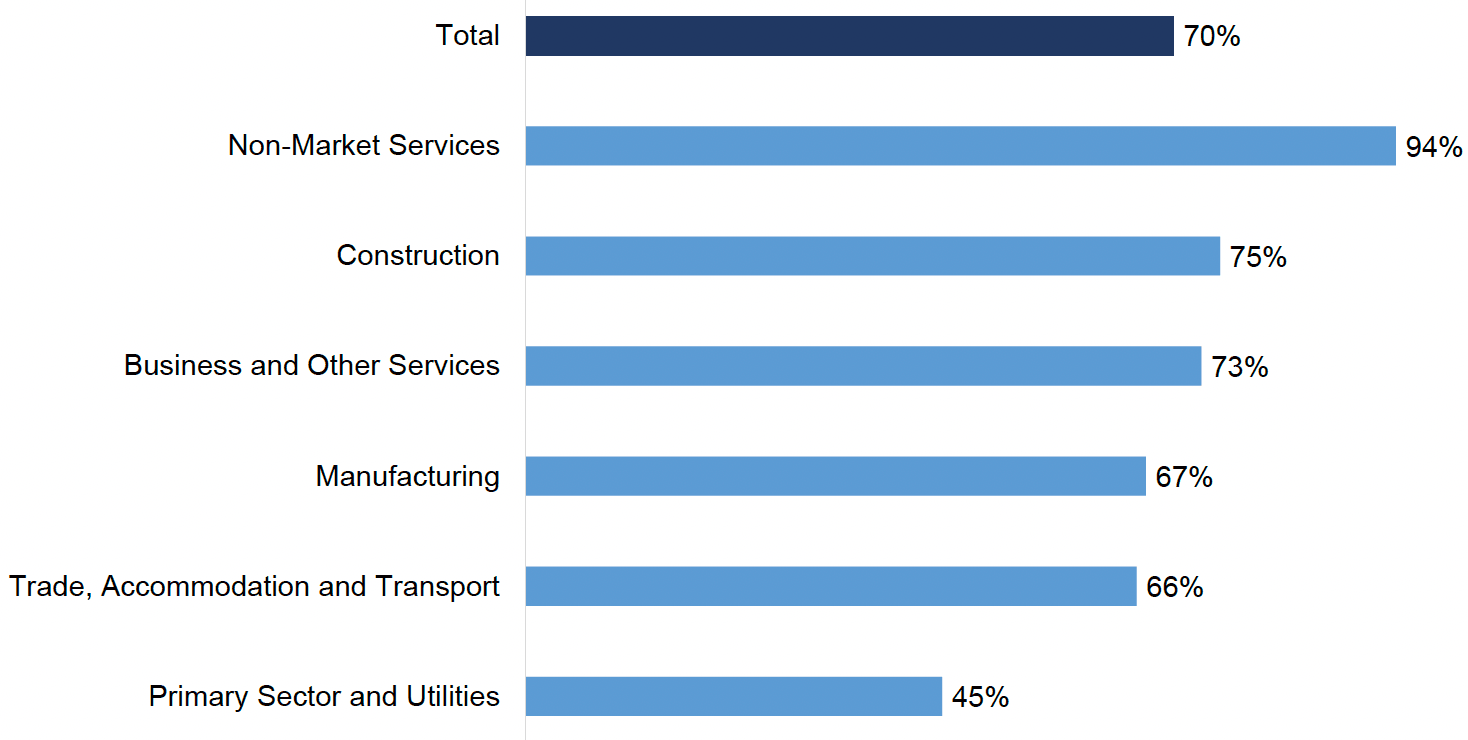
Base: All establishments: Primary Sector and Utilities (70); Manufacturing (61); Construction (65); Trade, Accommodation and Transport (357); Business and Other Services (281); Non-Market Services (166).
Around six in ten (62%) employers had provided internal training in the past 12 months, similar to levels in 2019 (60%) and 2016 (63%). In contrast, 44% had provided external training over the past 12 months, a decrease on 2019 levels (49%).
Overall, among employers that provided training, one in six (16%) had used public providers while six in ten (60%) had used any non-public training. The latter has declined compared to 2019 (65%). Around half (51%) of those that had provided training said this had been provided by commercial organisations, such as consultants or private training providers. A quarter had used suppliers (24%) and 18% used regulatory bodies for their training. The use of regulatory bodies for training has declined from 2019 (23%).
Around a quarter of employers (26%) had experienced a skills or training-related issue that required advice, information or support in the 12 months preceding the survey. This was similar to 2019 (29%) but lower than in 2016 (33%). Larger employers were more likely than smaller employers to have needed such support; a fifth (20%) of employers with 2-4 employees mentioned this, compared with around half (48%) of those with 100 or more employees. Among those experiencing an issue, eight in ten (80%) had sought or received advice on the issue, a similar figure to both 2019 (76%) and 2016 (79%). This equates to 20% of all employers having sought or received advice on skills and training-related issues.
Vocational qualifications
27% of employers have arranged or funded training designed to lead to a recognised vocational qualification in the last 12 months, decreasing from 2019 (31%), but similar to 2016 levels (26%).
This equated to 39% of employers who provide any form of training, a lower proportion than in 2019 (44%) but a similar level to 2016 (36%).
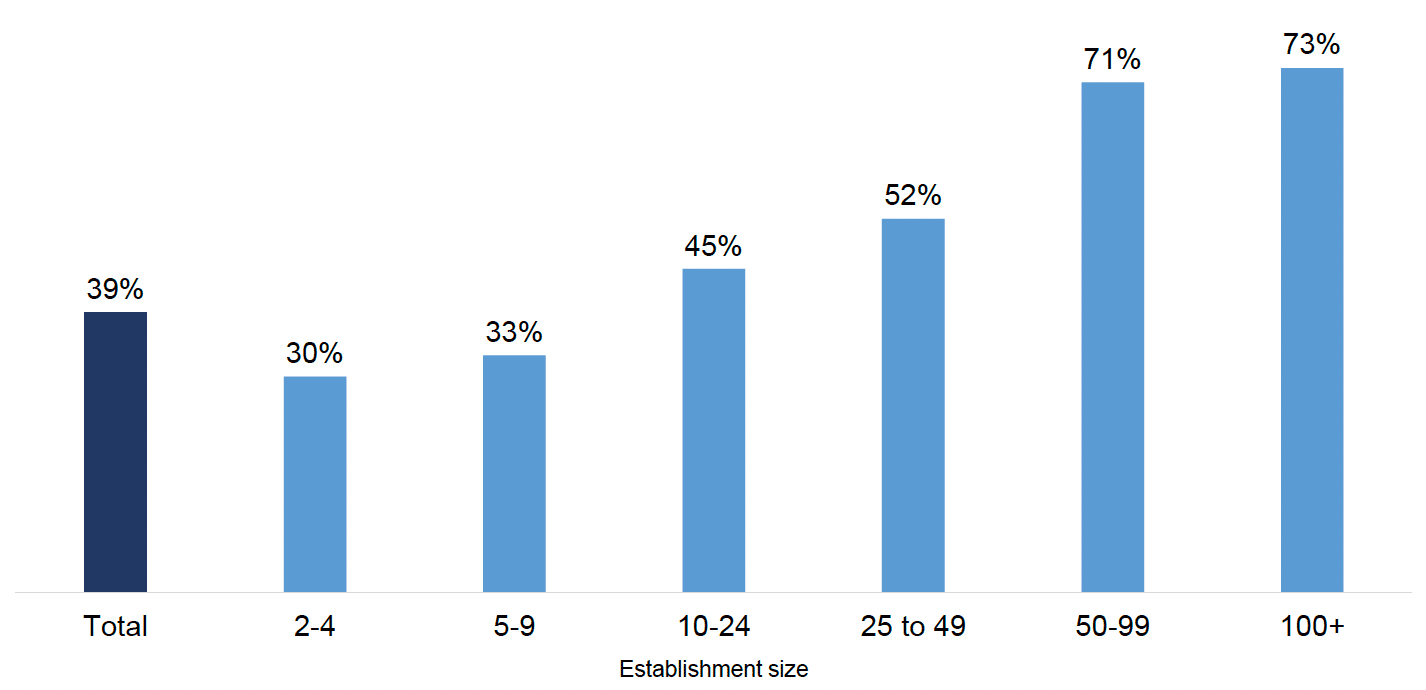
Base: All establishments providing training (817). 2-4 (124); 5-9 (187); 10-24 (218); 25-49 (128); 50-99 (77); 100+ (83).
As shown in Figure 10, the likelihood of providing training designed to lead to vocational qualifications among training employers generally increased with employer size, ranging from 30% among those with 2-4 employees to 73% among those with 100 or more employees.
The Construction (61%) and Non-Market Services (53%) sectors were most likely to have arranged or funded training designed to lead to vocational qualifications, while employers in Business and Other Services (33%); Trade, Accommodation and Transport (32%); and Manufacturing[14] (20%) sectors were least likely to have done so, as shown in Figure 11.
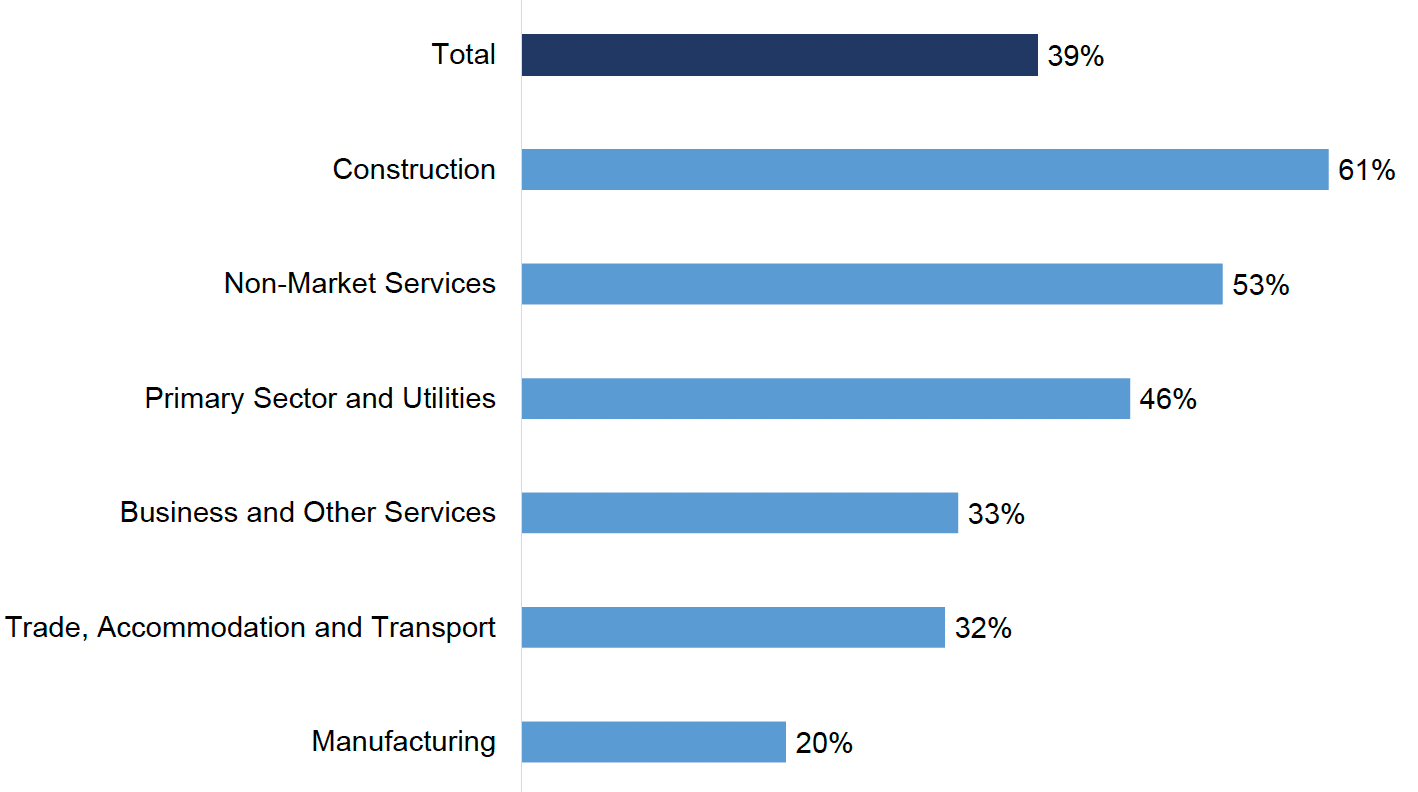
Base: All establishments providing training (817). Primary Sector and Utilities (46); Manufacturing (46); Construction (54); Trade, Accommodation and Transport (289); Business and Other Services (224); Non-Market Services (158).
Around half (52%) of those that offered vocational qualifications had had any involvement in designing the content for them. This is an increase from 44% in 2019. Around a third (35%) tailored or developed the content of existing external training to make it suitable to their needs while 5% devised the training content from scratch. A further 12% did both of these things, an increase from 4% in 2019.
Employers offering training towards vocational qualifications were positive overall about the impact they had on their business. The vast majority agreed that vocational qualifications lead to better business performance (88%) and that it helped with staff retention (80%); these results are consistent with 2019 (85% and 80% respectively).
In terms of the features of vocational qualifications, around eight in ten (81%) employers agreed that they can be adapted to business needs, while around seven in ten agreed that they cover all skills needed by the company and offers good value for money (69% and 73% respectively), all were in line with 2019 results (84%, 69% and 73% respectively). Employers with 100 or more staff were less likely to agree vocational qualifications offer good value for money (60%). A full breakdown of the perceived benefits and impacts of vocational qualifications can be found in Table 71 to Table 74 in the Background Tables.
Of the three prompted statements about the features of vocational qualifications, employers were least likely to agree that vocational qualifications cover all the skills needed by their company (69%).
Employers were asked the reasons why they had not arranged or funded training designed to lead to a vocational qualification. As shown in Figure 12, the most common individual reason given was that staff do not want vocational qualifications (30%). This was followed by training courses not running due to COVID-19 and the employer not knowing enough about what vocational qualifications are available (both 28%). A quarter (25%) also said that they were unable to fund training due to COVID-19, meaning that just over a third (35%) overall cited any COVID-19 related reasons.
Overall, barriers related to supply of vocational qualifications have increased from 48% in 2019 to 57% in 2021.[15] Around four in ten (42%) cited barriers related to demand as a factor and a similar figure reported resource-related issues to be an obstacle (41%), the latter is an increase from 2019 (33%). Employers in the Non-Market Services sector were least likely to cite demand as a factor (30%) but most likely to mention COVID-19 related reasons (50%).
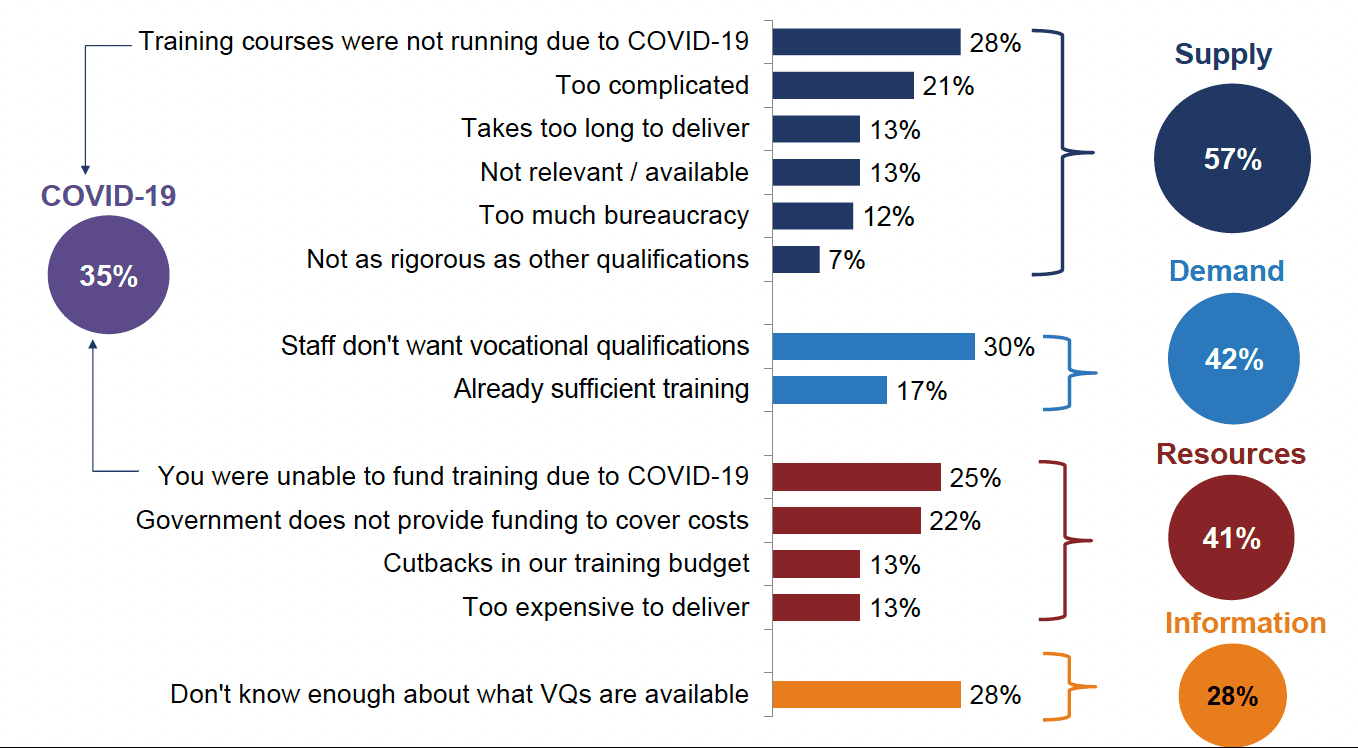
Base: All who have not arranged training in the last 12 months that leads to vocational qualifications (436). Only the barriers mentioned by 5% or more are shown.
Awareness of schemes or initiatives that help people development
The prompted initiatives employers were most familiar with were Individual Training Accounts and Partnership Action for Continuing Employment, or PACE (17% and 16% aware respectively).
Around one in ten (11%) were aware of the Flexible Workforce Development Fund, while only a small minority knew about the Scottish Union Learning Fund (3%) and National Transition Training Fund (2%). The proportion of employers aware of PACE has increased from 2019 (10%). Respondents were not asked about their awareness of Individual Training Accounts and the Flexible Workforce Development Fund in previous years.
Use of these initiatives was rare. Use of the Flexible Workforce Development Fund and Individual Training Accounts (both 2% of employers) was most common, followed by PACE (1% of employers had used PACE). The most commonly used initiatives in the public and voluntary sectors were Individual Training Accounts (11% in the public sector, 4% in voluntary sector) and the Flexible Workforce Development Fund (4% in both the public and voluntary sectors). No initiative was used by more than 1% in the private sector.
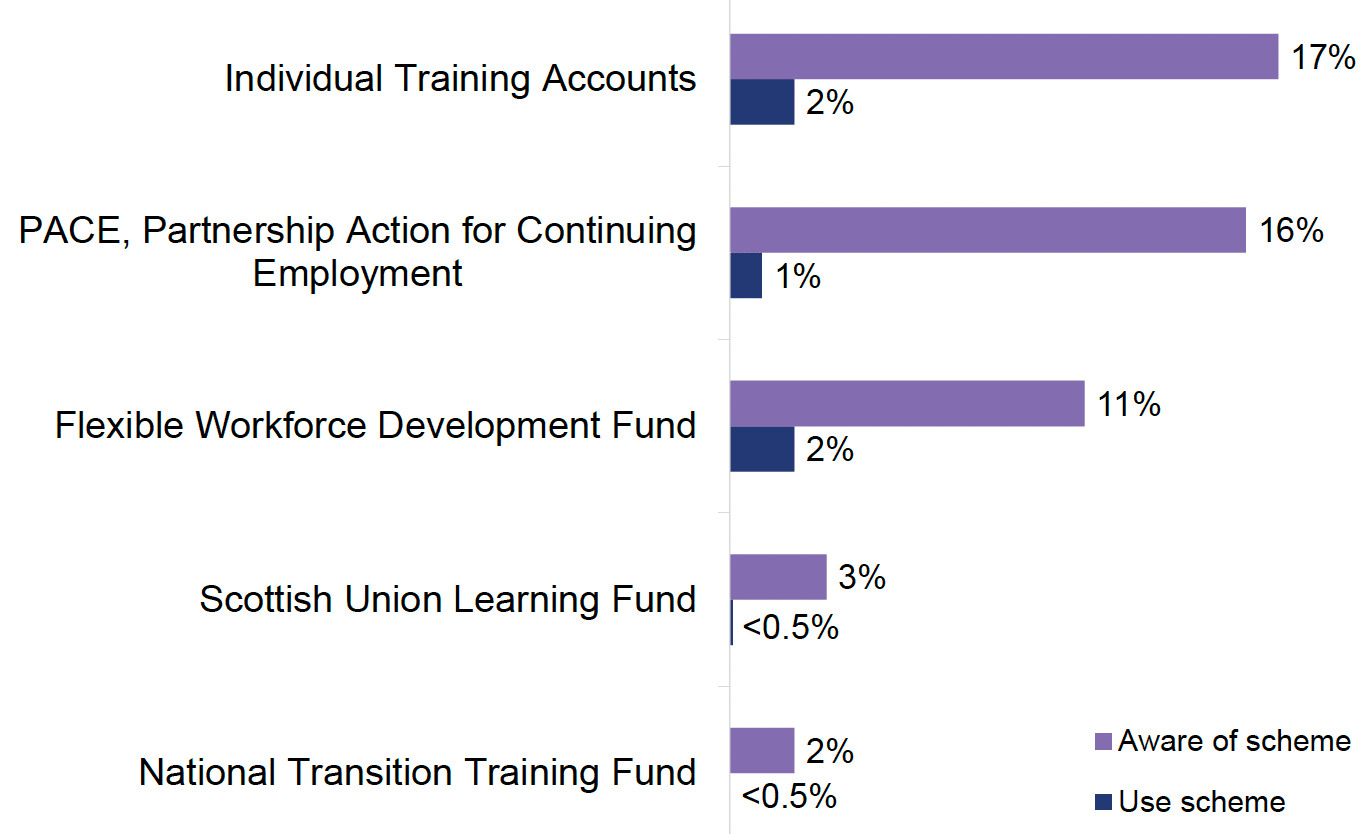
Base: All establishments (1,000).
Employer collaboration
One in six (16%) establishments had worked with other employers to develop skills or expertise in the workforce, similar to 2019 (14%).
This might include combining resources with other employers to fund a training course for staff at both/all participating organisations, providing training to (or receiving training from) staff from another employer, or working collaboratively to develop training policies and/or programmes for the employers' specific industry or region.
Employer collaboration was most common among establishments with 50 to 99 employees (31%); in contrast only 12% of those with 2 to 4 employees had done so. In terms of sector, those in Non-market Services were most likely to collaborate (35%), while this was less common among Trade, Accommodation and Transport employers (12%).
Contact
Email: FHEstatistics@gov.scot
There is a problem
Thanks for your feedback